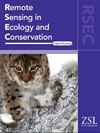Spectral characterization of plant diversity in a biodiversity‐enriched oil palm plantation
IF 4.3
2区 环境科学与生态学
Q1 ECOLOGY
引用次数: 0
Abstract
Assessing plant diversity using remote sensing, including airborne imaging spectroscopy, shows promise for large‐scale biodiversity monitoring in landscape restoration and conservation. Enriching plantations with native trees is a key restoration strategy to enhance biodiversity and ecosystem functions in agricultural lands. In this study, we tested how well imaging spectroscopy characterizes plant diversity in 37 experimental plots of varying sizes and planted diversity levels in a biodiversity‐enriched oil palm plantation in Sumatra, Indonesia. Six years after establishing the plots, we acquired airborne imaging spectroscopy data comprising 160 spectral bands (400–1000 nm, at ~3.7 nm bandwidth) at 0.3 m spatial resolution. We calculated spectral diversity as the variance among image pixels and partitioned spectral diversity into alpha and beta diversity components. After controlling for differences in sampling area through rarefaction, we found no significant relationship between spectral and plant alpha diversity. Further, the relationships between the local contribution of spectral beta diversity and plant beta diversity revealed no significant trends. Spectral variability within plots was substantially higher than among plots (spectral alpha diversity ~82%–87%, spectral beta diversity ~11%–18%). These discrepancies are likely due to the structural dominance of oil palm crowns, which absorbed most of the light, while most of the plant diversity occurring below the oil palm canopy was not detectable by airborne spectroscopy. Our study highlights that remote sensing of plant diversity in ecosystems with strong vertical stratification and high understory diversity, such as agroforests, would benefit from combining data from passive with data from active sensors, such as LiDAR, to capture structural diversity.生物多样性富集油棕种植园植物多样性的光谱特征
利用包括航空成像光谱在内的遥感技术评估植物多样性,有望在景观恢复和保护中进行大规模的生物多样性监测。以原生树种丰富人工林是增强农业用地生物多样性和生态系统功能的关键恢复策略。在这项研究中,我们测试了成像光谱在印度尼西亚苏门答腊岛一个生物多样性丰富的油棕种植园的37个不同大小和种植多样性水平的试验田中如何很好地表征植物多样性。在建立地块6年后,我们以0.3 m空间分辨率获得了160个光谱波段(400-1000 nm,带宽约3.7 nm)的航空成像光谱数据。我们将光谱多样性计算为图像像素间的方差,并将光谱多样性划分为alpha和beta多样性分量。在通过稀疏控制采样面积差异后,我们发现光谱与植物α多样性之间没有显著的关系。此外,光谱多样性的局部贡献与植物多样性之间的关系没有明显的趋势。样地内光谱变异性显著高于样地间(光谱α多样性为82% ~ 87%,光谱β多样性为11% ~ 18%)。这些差异可能是由于油棕树冠的结构优势,它吸收了大部分的光,而油棕树冠下的大多数植物多样性无法通过航空光谱检测到。我们的研究强调,在垂直分层强、林下植物多样性高的生态系统(如农林业)中,将被动传感器数据与主动传感器数据(如激光雷达)相结合,将有利于植物多样性的遥感。
本文章由计算机程序翻译,如有差异,请以英文原文为准。
求助全文
约1分钟内获得全文
求助全文
来源期刊

Remote Sensing in Ecology and Conservation
Earth and Planetary Sciences-Computers in Earth Sciences
CiteScore
9.80
自引率
5.50%
发文量
69
审稿时长
18 weeks
期刊介绍:
emote Sensing in Ecology and Conservation provides a forum for rapid, peer-reviewed publication of novel, multidisciplinary research at the interface between remote sensing science and ecology and conservation. The journal prioritizes findings that advance the scientific basis of ecology and conservation, promoting the development of remote-sensing based methods relevant to the management of land use and biological systems at all levels, from populations and species to ecosystems and biomes. The journal defines remote sensing in its broadest sense, including data acquisition by hand-held and fixed ground-based sensors, such as camera traps and acoustic recorders, and sensors on airplanes and satellites. The intended journal’s audience includes ecologists, conservation scientists, policy makers, managers of terrestrial and aquatic systems, remote sensing scientists, and students.
Remote Sensing in Ecology and Conservation is a fully open access journal from Wiley and the Zoological Society of London. Remote sensing has enormous potential as to provide information on the state of, and pressures on, biological diversity and ecosystem services, at multiple spatial and temporal scales. This new publication provides a forum for multidisciplinary research in remote sensing science, ecological research and conservation science.
 求助内容:
求助内容: 应助结果提醒方式:
应助结果提醒方式:


